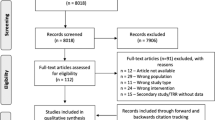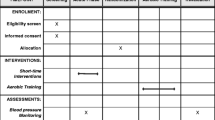Abstract
In the first of two studies, 42 unmedicated mild hypertensives completed either 16 sessions of thermal biofeedback (TBF) training for hand (7 sessions) and foot (9 sessions) warming or 8 weeks of monitoring BPs at home. There was a trend (p<.10) for more of those treated (57.1%) to have DBPs lower than 90 mm Hg than for those only monitoring BPs at home (33%). Analyses of clinic BP values from random zero sphygmomanometer measurements, from 24-hour ambulatory BP monitoring, and from home BP measurements made by the patient showed no advantage for treatment versus BP monitoring. Sixteen of the 21 patients in BP monitoring were later treated. Analyses of treatment effects across all treated subjects by gender revealed a significant (p=.02) decrease in DBP for treated female subjects (n=13) but not for males (n=24). In the second study the 22 initial treatment successes, that is, those whose DBP was below 90 mm Hg at posttreatment (59.4% of those who completed treatment), were randomized to an intensive follow-up (monthly visits for 6 months, then visits every two months) emphasizing regular home practice with an electronic TBF device or regular follow-up (visits every 3 months). Twelve of the 22 were still normotensive at 12 months. There were no differences at any point during the follow-up between the two conditions in success rate or BPs despite a numerical advantage in reported frequency of home practice by those in the intensive follow-up condition.
Similar content being viewed by others
References
Benson, H., Shapiro, D., Tursky, B., & Schwartz, G. E. (1971). Decreased systolic blood pressure through operant conditioning techniques in patients with essential hypertension.Science, 173, 740–742.
Blanchard, E. B., Eisele, G., Gordon, M. A., Cornish, P. J., Wittrock, D. A., Gilmore, L., Vollmer, A., & Wan, C. (1993). Thermal biofeedback as an effective substitute for sympatholytic medication in moderate hypertension: A failure to replicate.Biofeedback and Self-Regulation, 18, 237–253.
Blanchard, E. B., Martin, J. E., & Dubbert, P. M. (1988).Non-Drug Treatments for Essential Hypertension. Elmsford, NY: Pergamon Press.
Blanchard, E. B., McCoy, G. C., McCaffrey, R. J., Musso, A., Wittrock, D. A., Berger, M., Gerardi, M. A., Pangburn, L., Khramelashvili, V. V., Aivasyan, T. A., & Salenko, B. B. (1988). The USSR-USA collaborative cross-cultural comparison of autogenic training and thermal biofeedback in the treatment of mild hypertension.Health Psychology, 7, 19–33.
Blanchard, E. B., McCoy, G. C., Musso, A., Gerardi, M. A., Pallmeyer, T. P., Gerardi, R. J., Cotch, P. A., Siracusa, K., & Andrasik, F. (1986). A controlled comparison of thermal biofeedback and relaxation training in the treatment of essential hypertension: I. Short-term and long-term outcome.Behavior Therapy, 17, 563–579.
Brauer, A. B., Horlick, L., Nelson, E., Farquhar, J. W., & Agras, W. S. (1979). Relaxation therapy for essential hypertension: A Veterans Administration out-patient study.Journal of Behavioral Medicine, 2, 21–29.
Engel, B. T., Gaarder, K. R., & Glasgow, M. S. (1981). Behavioral treatment of high blood pressure. I. Analyses of intra- and inter-daily variations of blood pressure during a one-month baseline.Psychosomatic Medicine, 43, 255–270.
Fahrion, S., Norris, P., Green, A., Green, E., & Snarr, C. (1986). Biobehavioral treatment of essential hypertension: A group outcome study.Biofeedback and Self-Regulation, 11, 257–278.
Glasgow, M. S., Engel, B. T., & D'Lugoff, B. C. (1989). Control study of a standardized behavioral stepped treatment for hypertension.Psychosomatic Medicine, 51, 10–26.
Glasgow, M. S., Gaarder, K. R., & Engel, B. T. (1982). Behavioral treatment of high blood pressure II. Acute and sustained effects of relaxation and systolic blood pressure biofeedback.Psychosomatic Medicine, 44, 155–170.
Jaccard, J., & Wan, C. K. (1993). Statistical analysis of temporal data with many observations: Issues for behavioral medicine data.Annals of Behavioral Medicine, 15, 41–50.
Jacob, R. G., Chesney, M. A., Williams, D. M., Ding, Y., & Shapiro, A. P. (1991). Relaxation therapy for hypertension: Design effects and treatment effects.The Annals of Behavioral Medicine, 13, 5–17.
Jacob, R. G., Shapiro, A. P., O'Hara, P., Portser, S., Kruger, A., Gatsonis, C., & Ding, Y. (1992). Relaxation therapy for hypertension: Setting-specific effects.Psychosomatic Medicine, 54, 87–101.
Joint National Committee on Detection, Evaluation and Treatment of High Blood Pressure. (1993). The fifth report of the Joint National Committee on Detection, Evaluation, and Treatment of High Blood Pressure (JNC-V).Archives of Internal Medicine, 153, 154–183.
Kaufman, P. G., Jacob, R. G., Ewart, C. K., Chesney, M. A., Muenz, L. R., Doub, N., & Mercer, W. (1988). Hypertension intervention pooling project.Health Psychology, 7, 209–223.
McCaffrey, R. J., & Blanchard, E. B. (1985). Stress management approaches to the treatment of essential hypertension.Annals of Behavioral Medicine, 7, 5–12.
Musso, A., Blanchard, E. B., & McCoy, G. C. (1991). Evaluation of thermal biofeedback treatment of hypertension using 24-hour ambulatory blood pressure monitoring.Behaviour Research and Therapy, 29, 469–478.
Pickering, T. G., & James, G. D. (1989). Some implications of the differences between home, clinic, and ambulatory blood pressure in normotensive hypertensive patients.Journal of Hypertension, 7 (Supplement 3), S65-S72.
Rosen, R. C., Brondolo, E., & Kostis, J. B. (1993). Nonpharmacological treatment of essential hypertension: Research and clinical applications. In R. J. Gatchel and E. B. Blanchard (Eds.),Psychophysiological disorders: Research and clinical application (pp. 63–110). Washington, DC: American Psychological Association.
Surwit, R. S., Shapiro, D., & Good, I. M. (1978). Comparison of cardiovascular biofeedback, neuromuscular biofeedback, and meditation in the treatment of borderline essential hypertension.Journal of Consulting and Clinical Psychology, 46, 252–263.
Taylor, C. B., Farquhar, J. W., Nelson, E., & Agras, W. S. (1977). Relaxation therapy and high blood pressure.Archives of General Psychiatry, 34, 339–343.
Wittrock, D. A., & Blanchard, E. B. (1992). Thermal feedback treatment of mild hypertension: A comparison of effects of conventional and ambulatory blood pressure measures.Behavior Modification, 16, 283–304.
Wittrock, D. A., Blanchard, E. B., & McCoy, G. C. (1988). Three studies on the relation of process to outcome in the treatment of essential hypertension with relaxation and thermal biofeedback.Behaviour Research and Therapy, 26, 53–66.
Author information
Authors and Affiliations
Additional information
This research was supported by a grant from NHLBI, HL-31189.
Rights and permissions
About this article
Cite this article
Blanchard, E.B., Eisele, G., Vollmer, A. et al. Controlled evaluation of thermal biofeedback in treatment of elevated blood pressure in unmedicated mild hypertension. Biofeedback and Self-Regulation 21, 167–190 (1996). https://doi.org/10.1007/BF02284694
Issue Date:
DOI: https://doi.org/10.1007/BF02284694




